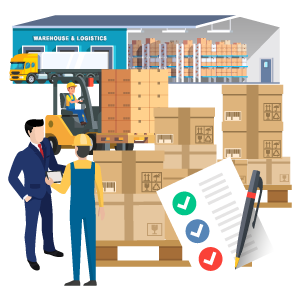Eye Opening Signs that prove You're Struggling with Inventory Management
For someone who has never had to deal with the chaos that goes on inside a warehouse, inventory management may sound like a very simple task. Products come in, products go out, and you try and keep track of where everything’s going the best you can. But as many people soon find out, it is not that simple.
Statistics show that one of the top ten reasons that start up companies fail is because of poor inventory management. People make the mistake of believing that having a strong system in place to organize inventory is not essential. Especially for smaller start up companies, inventory management systems often don’t make it into the budget, as they believe there are more important aspects of the business to invest in.
It is said that 7% of small businesses that have inventory don’t track their inventory at all. 15% use a pen and paper, 24% use a spreadsheet, and there are only 33% who use an inventory management software. No matter how it’s organized, there is so much more to order/inventory/warehouse management than keeping track of what goes in and out. Inventory managing staff must plan how much of a product to order and keep in stock, where they’re going to order from, how that inventory is going to come in and where in the warehouse it’s going to be located. They then must decide the workflow process for picking the item if it’s been ordered by a customer. It must then be cost efficiently packaged and shipped to the customer by the date it was promised to them. All of this needs to be kept track of, recorded, and organized in a way that reduces wasted time and room for error. For a business of any size, this is no small task.
As of 2015, studies have shown that businesses keep $1.43 of inventory for every dollar worth of inventory sold. This means that businesses are ordering more than they need and taking up more space in their warehouse with products that are not being sold.
Inventory Shrinkage
Inventory shrinkage is what occurs when records show that there should be more inventory possessed by the business than there actually is. There is no record of products being sold or moved, but they are missing. This can occur because of multiple reasons including inventory theft, damage, miscounting, incorrect units of measure, evaporation, or similar issues. Studies show that administrative, paperwork, and vendor errors account for 25% of all shrinkage. This means that it can be so easily avoided simply by having a good inventory management system in place to decrease errors.
Avoid Having Excess Inventory
The term Days Inventory Outstanding refers to the amount of inventory on hand based on average sales per day. Studies show that this number has risen 8.3% over the past 5 years. This is another example of how an inventory management system is useful in saving business overs money and time. A good inventory management system tracks your stock level, so that you can take the guesswork out of how much inventory you’ll need the next time you place a purchase order. This process will help you to avoid unnecessary spending and to avoid taking up valuable space in your warehouse.
Moving Away From Pen and Paper
Having to do everything manually when keeping track of orders and inventory can increase the probability of human error and undoubtedly require more time than having automated processes. Utilizing tools such as barcode scanners can help to speed up the warehouse processes greatly. As seen in many cases, an example where a medical center began using barcodes on medication reduced errors in administration by 41.4%. The decision to move away from manual processes and implement a software which helps to automate things will be an investment that benefits both staff and consumer.
Choosing an Inventory Management System that’s Right for You
It’s important for the success of your business to choose the right inventory management software to manage your ordering and warehouse processes that’s right for your unique business. There are many options when choosing an inventory management system, most similarly structured. The one order/inventory/warehouse management system that stands apart from the rest is SkuNexus. What makes SkuNexus so different than most is the ability to customize. With many systems, they give you a structure to be followed in order to keep things organized, which may work for some. But for most, it won’t be as successful as a customizable option. With SkuNexus, the software is built around your company’s desired workflow. If you already have workflow processes in place which work for you, SkuNexus can build out features to keep those processes. At SkuNexus, we also work together with the client to come up with new, more efficient ways of handling warehouse tasks. If we can save you time and money by implementing new workflow processes within your system’s features, there is no downside for anyone.
Contact us today for a demo and learn more about how SkuNexus can be the right solution for your unique business.








